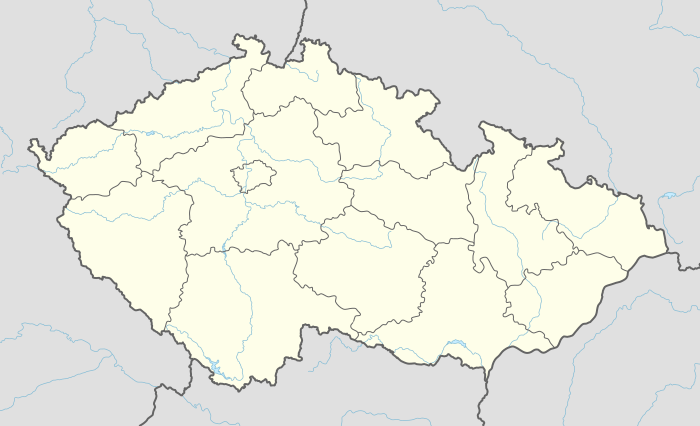Železná Ruda
Železná Ruda (literally "iron ore", Czech pronunciation: [ˈʒɛlɛznaː ˈruda], German: Markt Eisenstein) is a town in the Pilsen Region of the Czech Republic. It is located in the Šumava Mountains, close to the border with Bavaria and the German town Bayerisch Eisenstein. It is one of the important sports and tourism centres of the Šumava Mountains. The German name of the town comes from The Middle Ages, when it was a market town. Its German population was expelled after 1945.
Železná Ruda | |
|---|---|
Town | |
Aerial view | |
 Flag  Coat of arms | |
 Železná Ruda Location in the Czech Republic | |
| Coordinates: 49°8′28″N 13°13′48″E | |
| Country | Czech Republic |
| Region | Plzeň |
| District | Klatovy |
| Little District | Klatovy |
| Parts | List
|
| Government | |
| • Mayor | Filip Smola |
| Area | |
| • Total | 79.79 km2 (30.81 sq mi) |
| Elevation | 820 m (2,690 ft) |
| Population (2015-01-01) | |
| • Total | 1,745 |
| • Density | 22/km2 (57/sq mi) |
| Postal code | 340 04 |
| Website | https://www.zelezna-ruda.cz/ |
Geography and Climate
Železná Ruda, lying in a wild mountainous terrain at an elevation between 710 and 1,214 metres (2,329 and 3,983 ft), is surrounded with thick coniferous woods. Its climate is cool and wet humid continental hemiboreal (Dfb) with moderately cold, long winters and cool summers. Average July temperature is 15.1 °C (59.2 °F) and average January temperature is −4.2 °C (24.4 °F). Yearly average is 5.7 °C (42.3 °F) and there is some 967 mm of precipitation.
| Climate data for Markt Eisenstein - Železná Ruda | |||||||||||||
|---|---|---|---|---|---|---|---|---|---|---|---|---|---|
| Month | Jan | Feb | Mar | Apr | May | Jun | Jul | Aug | Sep | Oct | Nov | Dec | Year |
| Average high °C (°F) | −1.2 (29.8) |
0.1 (32.2) |
5.2 (41.4) |
10.3 (50.5) |
15.3 (59.5) |
18.6 (65.5) |
20.3 (68.5) |
19.7 (67.5) |
16.3 (61.3) |
10.7 (51.3) |
4.0 (39.2) |
0.2 (32.4) |
10.0 (50.0) |
| Daily mean °C (°F) | −4.2 (24.4) |
−3.4 (25.9) |
0.9 (33.6) |
5.3 (41.5) |
10.0 (50.0) |
13.4 (56.1) |
15.1 (59.2) |
14.6 (58.3) |
11.3 (52.3) |
6.4 (43.5) |
1.2 (34.2) |
−2.4 (27.7) |
5.7 (42.3) |
| Average low °C (°F) | −7.2 (19.0) |
−6.9 (19.6) |
−3.4 (25.9) |
0.3 (32.5) |
4.7 (40.5) |
8.2 (46.8) |
9.9 (49.8) |
9.5 (49.1) |
6.4 (43.5) |
2.2 (36.0) |
−1.6 (29.1) |
−4.9 (23.2) |
1.4 (34.5) |
| Average precipitation mm (inches) | 85 (3.3) |
60 (2.4) |
70 (2.8) |
59 (2.3) |
86 (3.4) |
96 (3.8) |
111 (4.4) |
101 (4.0) |
80 (3.1) |
64 (2.5) |
64 (2.5) |
91 (3.6) |
967 (38.1) |
| Source: Climate-Data.ORG | |||||||||||||
Places of interest
Natural
The town is surrounded by forests and green mountains. There are many popular tourist sites, such as the lakes Černé jezero and Čertovo jezero and Špičák peak (1,202 m).
Historical
Historical sites include the Church of Panna Maria Pomocná z Hvězdy (with an Eastern-style cupola), the Chapel of St. Barbora (saint of mineworkers) and the Way of the Cross. The local museum and information centre are located in a house, which was the home to a well-known family of glassmakers in the past. There is an exhibition of traditional glass, documents and photographs concerning history available all year round.
Technical
The longest train tunnel (1,747 m) in the Czech Republic goes under Špičák peak.
Economy
The local economy is very dependent on tourism because Železná Ruda is one of the most popular skiing centres of Šumava, as well as a starting point for many hiking trips on both sides of the border. The town has also gained a reputation as a hotspot for prostitution since the Velvet Revolution.[1][2][3]
Transport
The town is located on a train line leading from Plzeň and Klatovy to the border station at Bayerisch Eisenstein, named Železná Ruda-Alžbětín in Czech. This station building is divided by the national border between the Czech Republic and Germany.
References
| Wikimedia Commons has media related to Železná Ruda. |
- http://cestovani.idnes.cz/zelezna-ruda-trhy-a-prostitutky-v-raji-sumavskem-f7q-/igcechy.aspx?c=A070920_154313_igcechy_tom
- http://www.denik.cz/plzensky-kraj/vykricene-domy-pomalu-mizi-prostitutky-konci-s-zivnosti-20120402.html
- http://www.lidovky.cz/prostitutky-dostanou-prukazky-dn7-/ln_domov.asp?c=A080827_090209_ln_praha_svo